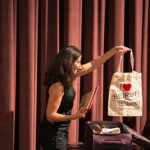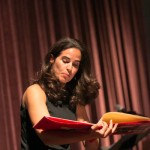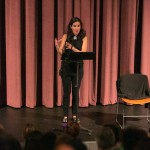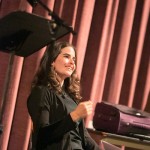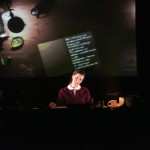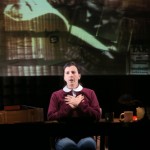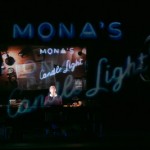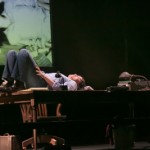CFA Arts Administration Intern Chloe Jones ’15 talks to Theater major Sivan Battat ’15 about her Senior Capstone Project, “The Serpent,” created in collaboration with her seven person ensemble, design team, and faculty advisor, Professor of Theater Yuri Kordonsky.
Can you talk a little about the history of “The Serpent” and the play itself?
This play emerged from the Open Theater and was created through a long process of exploring themes of the Bible. Playwright Jean-Claude van Itallie did extensive interviews with each of his actors, and all their text ended up in the script. It’s like a mash-up of biblical narrative and contemporary experience. The play was traditionally done as a kind of a Eucharist, a communion between actors and audience. It’s labeled The Serpent: A Ceremony. Mr. van Itallie wanted it to be a ceremony that reflected the lives and the minds and the experiences of the people performing it. That was the intention of The Serpent from day one. So our production does that. A lot of the text is the actors’ and was generated through a series of devising exercises throughout the first half of the semester. It’s a combination of Mr. van Itallie’s text, text from the Bible that he put in the script, and then our own words to replace some of the experiences in it that were maybe outdated for us or not as accessible.
Why did you choose “The Serpent” for your Senior Capstone Project?
I chose this for my capstone because I was interested in devised theater processes. Devised theater is ensemble-generated material that you then use to create a piece. A playwright or director doesn’t come in with the material, and often it will happen without a director. I was interested in the role of director in devised theater, and I was interested in the elements that make a strong ensemble. What are the things that I, as a director, have to do to make this feel like a safe space, to make this feel like an ensemble, to make this group of people function as one unit that can create? So I was curious about those things, but most devised processes are so long-term. You have to explore for so long and generate for so long, and I was worried that, realistically, with college actors and everyone doing a million other things, to do a legitimate devising process in one semester wouldn’t be possible. So I decided to find a text that I could begin with, as the foundation, and then riff and devise off of the text, and The Serpent was the perfect tool for that. It’s a very flexible text that allowed us to riff in different directions and explore and really dive into the themes of it and generate and then plug back into the text.
How did you cast the ensemble?
I cast it saying I was looking for writers, dancers, actors, musicians, anyone. More than anything I wanted people who I really wanted to work with, people who I wanted in the room every day and who would bring themselves to the process and fearlessly try.
What was your process like?
The whole process was very collaborative. The first half of the semester was really about playing, and while we maybe didn’t have as much time to put the thing together as we would have loved, having the first half of the semester to just play was awesome—to be able to say, for example, let’s all bring in ten images of what comes to mind when you hear “The Garden of Eden,” and then pick one image and make a movement score that represents that image to you in some way, and then someone else make sound for that movement score. It was a process of picking apart our stereotypes of God and challenging our stereotypes of what Eve looked like or what she felt. I remember one of my favorite rehearsals—I brought in an apple and told the actors to respond as Eve might have responded and that we were going to go until they couldn’t think of any other ways to respond. So one by one they took the apple—like a Whose Line Is It Anyway? type of improv game—and they each took a bite and responded a different way. We went for an hour and a half doing this.
What have you learned from the process?
I’m a little concerned that this piece is not very accessible, and I think one of the big things that I’m taking away from this is that I want to make work that is accessible. It bothers me if things are inaccessible, and that’s an important thing to have learned about my own work. I’ve also learned a lot about ensemble building and the tools that are most helpful in making an ensemble. Something I’m always working on is how to negotiate the relationship between actor and director. I’m always learning more about that. With every rehearsal I learn something new. And I’ve learned so much from them—each of the actors and designers has brought so much of themselves to the process.
At the end of the day, what is this play about for you?
I think it’s about being in the middle. I think it’s about transitional moments in our lives—the moment when we bite, the moment when we kill, the moment when we grow up. It’s about being between the beginning and the end, and always this experience of middle-ness because that’s what life is—there are transitional moments, but there are never stops.
The Serpent: Senior Capstone Project by Sivan Battat
Thursday, December 4 through Saturday, December 6, 2014 at 8pm
Patricelli ’92 Theater
FREE! Tickets required. Tickets will be made available on the day of each performance at the Wesleyan University Box Office. Off-campus guests may call the box office at 860-685-3355 after 10am to reserve tickets to be held in their names until fifteen minutes prior to curtain. On-campus guests must pick up their tickets at the box office. There is a two-ticket limit per person for free ticketed events.



